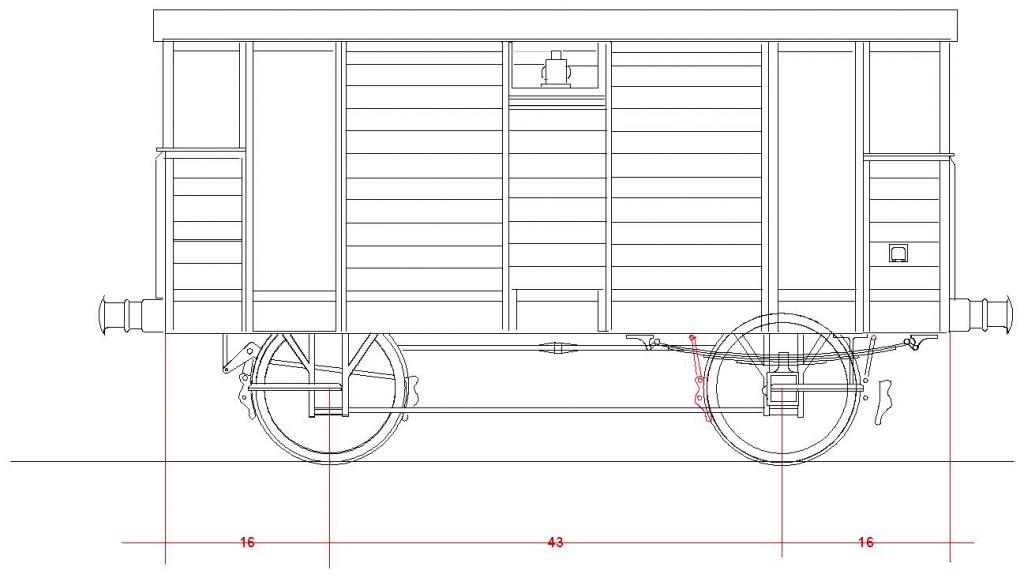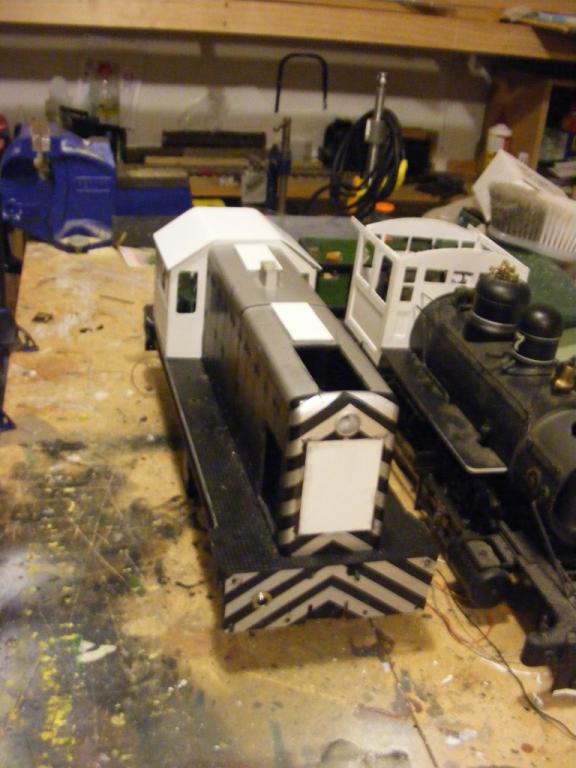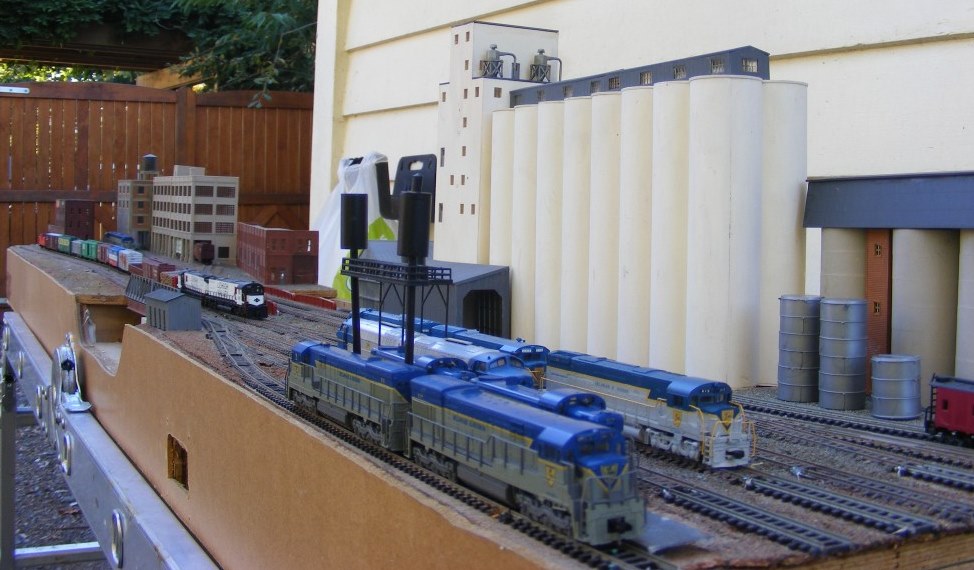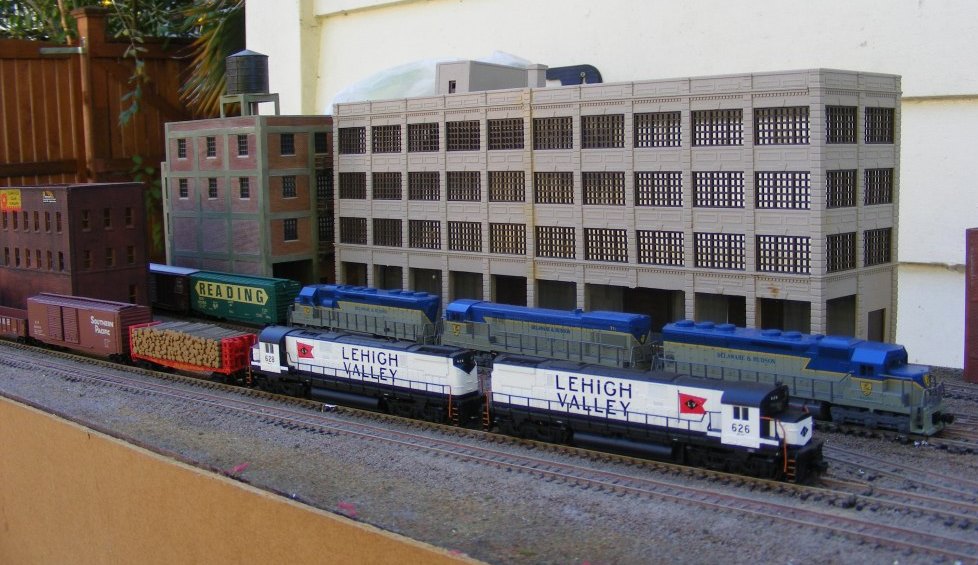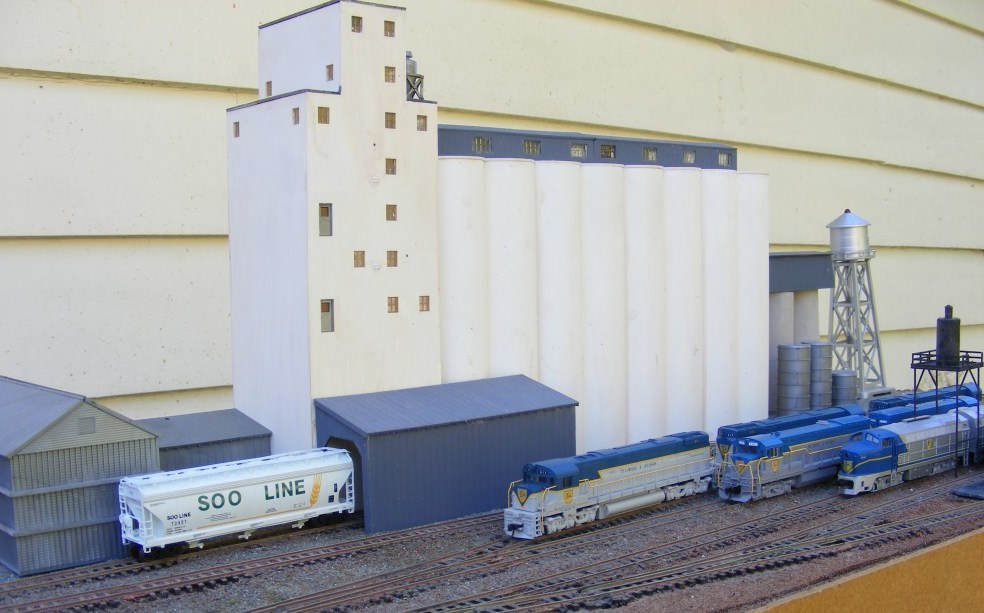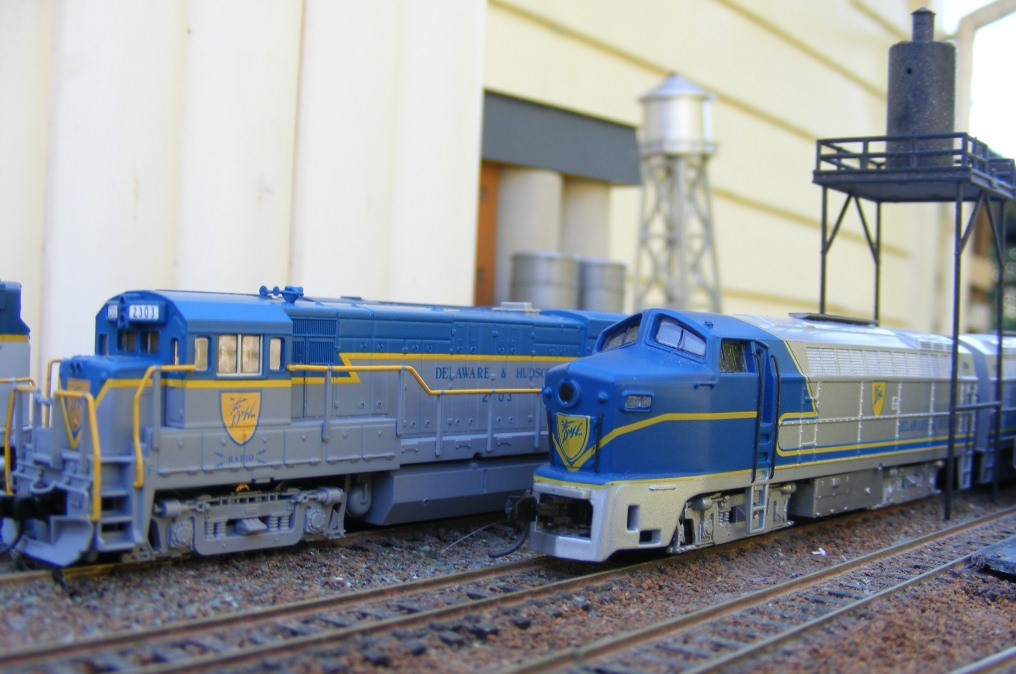-
Posts
4,853 -
Joined
-
Last visited
-
Days Won
119
Content Type
Profiles
Forums
Events
Gallery
Blogs
Store
Community Map
Everything posted by Mayner
-
I suppose it boils down to balancing expectations and price. Leslie initially mentioned a 20' skeleton container flat, Bulleid Open and possibly a Cement bubble in the £20-30, in resin similar to Leslies other hand built wagons. Presumably hand finished vacuum resin castings from a scratchbuilt master. A number of people have suggested using a proprietary rtr chassis, the main draw back is that the Dapol or Bachmann chassis are too long and narrow and have running gear that does not look remotely like the standard CIE 20' chassis and they are absolutly no use for a skeletal flat. Provincial Wagons have already proven a correct chassis can be done with the GNR Cattle and Covered Goods Vans, there is little point in continuing to go down the same road using proprietary chassis as IFM & MISOR. The Dapol Prestwin is a tad short but would pass muster for a steel decked wagon or cement bubble, but would add considerably to the final cost. Although I have not seen the Provincial Wagons or MISOR Guinness container wagons in the flesh, the MISOR wagon appears to be a higher priced but better model with the Bachmann chassis set back behind a set of cosmetic solebars presumably cast as part of the wagon deck. As far as the quality of the product goes no one is buying blind the quality of the models is pretty evident from PM & IFM have websites/price lists all of which have photos of the wagons.
-
Rich has basically said what I was going to say if someone is going to the trouble of comissioning a rtr chassis the cost of tooling up and producing a chassis of the right width will not to affect the cost. A narrow OO width chassis will look crap too narrow for OO Gauge container or wagon body. The problem of fitting OO gauge wheelsets can be got round by using a longer axle or forming a boss on the back of the axle guard, like the old MIR wagons I think an injection moulded or die cast bogie flat on injection moulded bogies would be a better option for a rtr model than a 4 wheeler. The main problem with the 4 wheelers is an injection or resin model would be too light and a die cast chassis more expensive and complex to manufacture.
-
I dont think anyone has asked for 21mm gauge rtr models, but if someone is going to the trouble of designing or commissioning a wagon or coach its a small step to at least explore the option of specifying OO Gauge wheel sets on 28mm axles. As Rich hinted the main issue with the skeletal flats and oil tankers is that its impossible to design a chassis that looks remotely right unless the solebars and axleguards are in the correct position. MIR managed to produce whitemetal wagon kits that were easy to re-gauge 30 years ago, so there should be little problem in designing a model with the solebars, axleboxes and brake shoes in the right position, the set up costs for OO wheelsets with slightly longer axles should be minimal on a run of 1000 wagons. Personally modelling Irish Broad Gauge using HO or EM gauge track creates more problems than it solves, as apart from having to scratchbuild everything the track is now a different scale to the models. For "modern image" its probably best to stick with 4mm its basically a matter of swapping out the wheelsets with MM diesels and replacing coach and wagon bogies, for steam outline the Tyrconnel & North Star kits are probably the way to go, its an easier scale to work in and Slaters supply suitable wheel sets and axles.
-
The CIE 20T van was based on an older GSWR design, CIE tended to scrap anything not built in Inchacore and most DSER, MGWR & West Cork Vans had gone by the 1960s. Some of the older vans were quite Wild West with raised cupolas and drovers compartments. I will post up some sketches when I get a chance
-
David We seem to have managed to turn Arigna into a major industrial centre with coal & iron traffic flowing over the SLNCR and narrow gauge connections to Sligo port and eastwards to the GNR at Belturbet!
-
I think there is a serious risk of duplication here, Leslie seems to be looking at commissioning a resin model from a scratchbuilt master similar to his GNR wagons, rather than commissioning a low priced mass produced wagons from China. IFM & MISOR already have or are planning to release similar priced OO Gauge wagons including Cement Bubbles, tank wagons and hoppers.
-
Along with footballs Mayco made plastic toys as part of the 'Buy Irish" campaign and may have had Government support through the IDA and special freight rates with CIE. There seems to have been a few de-railments of the Ballina Goods, for years I had an Evening Press clipping of a pile up of wagons at either Castlerea or Ballyhaunis as a result of a broken axle, the driver was unaware of the accident until the signal man at Claremorris asked what happened to the rest of your train? The B121s had lower braking power than the Bo Bos with only pair of brake cylinders per bogie, not good for holding a heavy loose coupled train on the long down grade from Donamon to Roscommon. CIE were fairly tight for locos in the 60s & 70s and most GM Bo Bos were repaired following collision damage. With the arrival of the 071s and ending of loose coupled freight and later DART there was basically a surplus of locos in the 80s with many 001 Class stored unservicable at Inchacore Works.
-
The "spine" wagons actually had a wooden planked floor, were 20' over headstocks and rated for 12T, most seem to have been phased out of revenue traffic and converted to sleeper wagons or Departmental stock, as 20T steel floored flats and skeletals were introduced in the late 60s. The wagons seem to have been used for Guiness traffic to Derry and possibly Donegal as there is footage of a couple of a goods departing Foyle Road with a couple of these wagons behind a Mogul. In the mid-late 1980s these old Guinness containers were conveyed to Adelaide inside CIE Half-Height Containers on standard 20T flats.
-
I think the bigger question is whether Government should protect the interests of the citizen or powerful vested interests. My experience with Government in Ireland, the UK and NZ drives me to a more and more Libraterian view point, although I work for the durn Government. A lot of todays problems from Syria to the United States are similar to Russia at the turn of the last Century people have got a taste for freedom and Governments are struggling to put the genie back into the bottle. Its interesting to see that the US Federal Government are prepared to override a citizens common law right to defend themselves when it suits vested interests in the arms industry. The interesting thing is that US gun laws are derived from the old English Common Law right for a person to defend themselves.
-
Or better still
-
The physical and e-mail address are from New Irish Lines, if the wagons are as good as Alan O'Rourke's review the guy deserves our support.
-
It looks like we may have a newwagon builder in the Midlands:banana:, rtr open beet wagons & H vans are available from Model Irish Scale Rail, 2 Coneburrow Road, Edenderry. misr@eircom.net The May edition of New Irish Lines includes a favourable review by A J O'Rourke. The models are resin on a modified Dapol chassis, "the bodies are very neat. The rather complex arrangement of the corrugation in the opens is well captutured". "The paint finish excellent' The inside of the beet wagons are said to be flush and MISR (James MacKay) appears to be working on a range of wagons including the CIE 20T brake and other traditional wagons. The review includes a screenshot of a 3D model so the wagons may be resin castings produced from a virtual master, this avoids the stepping present with 3D printed models.
-
Somehow or other I dont think ol Neil was exactly a GSWR fan probably more Great Northern or NCC....................Sweet Home was Lynard Skynard's response to Neil Youngs "Southern Man" "Watergate does not bother me, does your conscience bother you? Tell me true"..................... despite this the Van Zants & Young remained good friends I have always been tempted to check to hook up a Lionel loco to a sound system, at one time Ol Neil bought the company and spent a lot of time and money developing a sound system, I wonder if there is much feedback
-
, Now the fiddly bit fitting the wheels and setting up the second solebar, the underframe ribs and ends help locate and align the solebar. Two assembled wagons, the brake gear is the most difficult part, there is nothing to positively locate the brake shoes or vacuum cylinder, while the plastic shaft that runs between the V hangers is not exactly the most practical of ideas. The wagon on the left is similar to a pair of T&D ballast wagons sent to the C&L in the 1950, while the wagon with rounded ends is supposed to be typical of West Clare Practice. On the way to the paint shop surprisingly the Parkside wagons are the same width but shorter than my C&L opens. Now for something completly different. I bought a Bachmann Large Scale 45 Ton centre cab diesel several years ago, I was not happy with the appearence or performance, she towered above the LGB stock and had a habit of blowing up decoders. The loco was converted to battery operation as an end cab unit a couple of years ago but I was still not happy with the general appearence So a trip to the shops for re-building just need the overhead gantrys to look the part The loco was stripped down to the underframe in order to "narrow it a little bit" Re-assembly in progress underframe narrowed, new cut outs in body for radiator air intake grills and outlet, old radiator grill filled in, new hood access panels, low profile GE cab. Cab fabricated from 0.75-1.5-0.75 plasticard and ABS. windows in 0.75mm material cut out with craft knife, 1.5mm with piercing saw and files. These days I generally produce a full size drawing of the part and fix it to the plasticard with spraymount, as errors usually occur in transferring dimensions from a drawing to the material for cutting. I kept the Bachmann 1:20.5 scale control stand although the driver will need to go on a diet to fit in a 1:22.5 Scale Cab its no worse that some of the NZR classes. This could be a quick re-build as the little Porter is doing most of the work at the moment, and the steamer is a long term re-build into a C25 ,shorten front frame new cab, smokebox and funnel, new tender body, new tender bogies. I will probably go for a DRGW style repaint more GSR paint with yellow trim and yellow warning stripes similar to the Georgetown Loop diesels.
-
The postman has been busy today two little packages arrived from the UK this morning one with loco and tender wheels the other with a pair of narrow gauge wagon kits and another package of wheels. Parkside produce a wide range of narrow and standard gauge wagon kits in most of the popular scales, including a small range of Tralee & Dingle Kits while the BR Ply sided van is a good basis for a conversion into the ex-GNR Cement Vans and with a little more work a standard CIE H Van, while the BR Palvan forms a good basis for the CIE Sliding Door Pallet Vans. These kits used to be fairly basic but they no longer fit into the cheap and cheerful category quality has improved dramatically over the past 20 years. I tried a couple of their T&D wagon chassis as a basis for some coal wagons then Parkside released a 3' Gauge Irish open wagon based on Tralee & Dingle & West Clare practice. The Tralee and Dingle was notorious for its cheap construction and poor management, but they got it right with locos and stock, with Tralee & Dingle hand me downs finding their way to the West Clare and Cavan & Leitrim. The kits are fairly typical Parkside with nice body mouldings and the chassis in black plastic, the Tralee & Dingle wagon chassis is unusual by Parkside standards having the W Irons separate from the solebars. I usually smooth the edge of the solebar by lightly rubbing it along a file, (draw filing) this takes out any ridges or moulding lines, some of the older Parkside BR chassis used to be rough in this respect. Parkside supply brass top hat bearings with their 12mm and OO Gauge kits, this and pin point axle wheel sets is one of the secret of smooth running. Gently press the bearing in with a pliers. The W Irons locate into rebates in the solebar. Check that the W Irons align before the weld cures. Although the instructions recommends assembling the chassis before the body, I decided to fit the ends first in order to keep the solebars square. The little moulding pips need to be removed as they foul the sole bars. Solebar and one end fitted
-

Great Southern Railways Pullman coaches
Mayner replied to jhb171achill's question in Questions & Answers
There are photos of Pullmans on P94 "Irish Railways in Colour from Steam to Diesel" Tom Ferris Midland Publishing ISBN 1-85780-000-1 and p 37 Irish Broad Gauge Carriages Des Coakham Ian Allen ISBN 1 857850-175 X The photo in Irish Railways is of a withdrawn coach in early CIE dark green livery in poor condition with the peeling revealing cream upper panels between the windows. The photo in Irish Broad Gauge carriages is of a coach at Kingsbridge in Pullman livery, the author notes that the coaches were fitted with tip up seats which were uncomfortable by the standards of the 1950s -
I have a bottle of Export together with a couple of bags of Taytos in my survival pack under the desk at work. I worked in the bar trade 9in Dublin) at one stage and a number of regulars would touch nothing but a 'pint bottle of Guinness by the neck".
-
An interesting find, conditions were certainly cramped compared to Diesel No 1 in Inchacore. The Metrovicks were assembled in a British Railways Carriage shops in Manchester, carriages are visible in the bays on the right. At the time the choice of Metrovick may have not been so odd they had supplied most of British and South African straight electrics and Crossley had a good name as an engine builder.
-

Great Southern Railways Pullman coaches
Mayner replied to jhb171achill's question in Questions & Answers
At least some of the bogies survived for a long time after the coaches were scrapped. For many years after the Lisburn crash the remains of 010 sat on a pair of Pullman Bogies outside Diesel No 1 Inchacore. An A Class on Pullman Bogies with one cab cut away would make an interesting model -
I havent read this thread before and frankly, gobsmacked by the time effort and money put into running the site. Considering the problems we had with earlier sites, perhaps its time for the rest of us to consider a fund raiser for the keep Stephen solvent fund?
-
The old railway owned container depot with its gantry crane is tending to be a thing of the past, much of todays freight generated by Logistics, Port and Shipping companies now handled in new purpose built depots in Industrial areas with good road and motorway connections like Daventry freight terminal in the UK. This has started in Ireland with the IWT traffic and the new siding into Dublin Port, Logistics companies are more likely to consider rail for line haul work between distribution depots and the ports as Irish Rail are no longer in direct competition as a door to door delivery service. Its hard to second guess what is going to happen, but businesses are begining to seriously invest in rail, currently freight in Hamilton is handled in a new depot jointly owned and operated by the railway and a major customer on the city ring road, and two major private railfreight terminals are planned and we do not have Irelands manufacturing expot base.
-
Might have to get John Campbell to do a live steam conversion I just might have to sell the N gauge collection and try a scale where I can actually see the models.
-
Probably one of the furthest travelled layouts I started these modules in Dublin about 15 years ago, they became the centre piece of a larger layout before a move to New Zealand and incorporation into another layout. The boards sat on a shelf for 5 years in our new home before dusting off for these photos. If I ever get round to it the buildings could end up in a new L shaped layout in the home office. A freight from Washington arrives in town behind LV power as a pair of D&H U30Cs wait to take over for the run to Montreal. Inspired by the D&H & EL operation in Binghampton I cherry picked various features only to find the original was not as visually interesting. A pair of Atlas LV C628 "Snowbirds" Kato D&H SD45s & U30Cs in the background. D&H power on the service tracks Atlas C628s & U23Bs ER Models (Bachmann) RF16s Stages in evolution GE U25B keeps company with Baldwin Sharknose
-
Great news I might have to trade the smaller stuff in for the Tralee & Dingle Kerr Stuart
-
More or less like towing a car mainly by feel ! The drivers may have used whistle signals before starting off, applying and releasing the brakes, but the driver on the trailing loco would mainly be dependant on the movement of the train and road knowledge when to put on steam or ease off. I once drove small diesels in the UK, it is much the same with double heading the main thing is to avoid sudden starts or snatches otherwise you can break a coupler or tear the end out of a wagon. Great video ianyone notice the NIR logo on the loco at the quarry? the most striking thing was the youth of the lads watering the loco at York Road, I wonder were they railway employees or a couple of lads helping out at the shed on a Saturday morning, things were a lot more easy going in those days!
.png.c363cdf5c3fb7955cd92a55eb6dbbae0.png)

